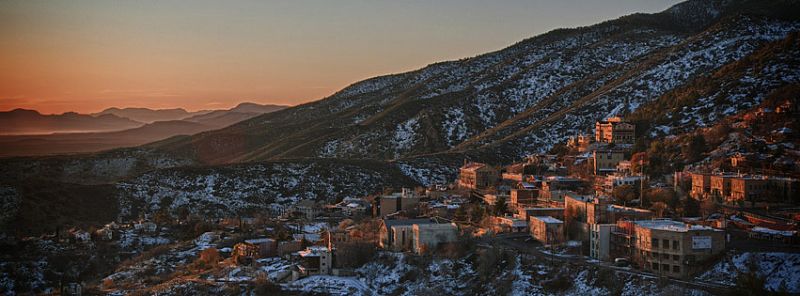JEROME: Then and Now
Jerome, Arizona, incorporated in 1899, is located in Yavapai County, approximately 100 miles north of Phoenix and 45 miles southwest of Flagstaff on State Highway 89A. The town sits perched on a hillside at an elevation of over 5,000 feet in the Black Hills of Arizona.
Town History
The Hohokam people were the first inhabitants in the vicinity of Jerome. They were peaceful people who farmed the Verde Valley between 700 AD and 1125 AD. Later, other Native American tribes inhabited the area and they worked the ore body on the hills around Jerome to collect pigments for coloring their bodies, blankets and clothes. In the late 16th century, Spanish explorers arrived in search of gold; however, they did not stay to mine the area when gold-hungry administrators determined that the “poor copper” mines did not warrant exploitation.
In 1875, the first mining claims and a mill site were located near the present site of the Town of Jerome at the base of two large cone-shaped hills, later called Cleopatra Hill and Woodchute Mountain. These claims were purchased by the United Verde Copper Company, organized by Frederick Tritle. The camp was named Jerome for Eugene Jerome, a major financier of the United Verde Copper Company. A small blast furnace was hauled in by wagon, and copper was produced in 1883 and 1884. By 1887, the operation closed, and in 1888, William Clark bought a majority of the stock and developed the operations into a profitable business. The small blast furnace produced nearly $1 million in copper and is on display today in Jerome.
New ore bodies were found and mining operations grew. New smelter and a narrow gauge railroad to the main line were built. Eventually, the smelter towns of Clarkdale and Clemenceau, complete with standard gauge railroad, were built to handle the ores being mined in and around Jerome. During the boom years that began in the early 1900s, Jerome was a diverse community, with over 30 different nationalities inhabiting the town of nearly 15,000 people.
During the latter part of the nineteenth century, at least five major fires ravaged the hastily constructed frame buildings that made up most of the town. Despite resistance from George W. Hull, Jerome’s largest landowner, the woeful lack of an adequate water supply and firefighting equipment drove the residents of Jerome to petition Yavapai County for incorporation. In 1899, the County Board of Supervisors granted incorporation for Jerome. The new Council promptly outlined a fire district and a building code was adopted, designed to lessen the occurrence of fire. Jerome prospered until the lack of high grade ores and the Depression signaled its decline.
Severe slides plagued Jerome and caused extensive damage. All of the vegetation for miles around Jerome had been killed by smelter fumes, causing excessive runoff and soil erosion. After the high-grade ores played out, open pit blasting started. Blasts of 5,000 pounds of explosives rocked the town. Tunnels were dug, then filled with large amounts of explosives (ranging from 50,000 to over 200,000 pounds) and detonated. The major slides took place after these large blasting activities.
Major mining activities ceased in 1953 and the population dropped to under 100 by the late 1950s. The decline of the town was hastened by the demolition of sound buildings for their materials. Lack of maintenance and a large snowfall in 1967 destroyed more of the remaining structures. In 1953, some of the few remaining residents formed the Historical Society to preserve what remained of the town.
JEROME TODAY
Jerome is a town known for its tenacity to survive in the face of impeding economic, environmental, health and topographic catastrophe. Crashing copper prices, sliding topography, mud, fires and disease are among the natural and manmade disasters that plagued the town throughout the 20th century.
The mines, the workers, those who sought its wealth, and those who came later in the 1960s and '70s formed Jerome's history. Today's Jerome, while retaining its mining camp heritage, has undergone a personality change. Jerome is now a bustling artistic community with a population of approximately 444, according to the 2010 U.S. Census. It includes artists, craftspeople, musicians, writers, hermits, business owners, historians and families. Together, they form a peaceful, colorful, thriving community built on a rich foundation of history, art and lore, and the town has become a major attraction for visitors to Arizona.
Jerome began its association with the arts when the Verde Valley Art Association was started in the early 1950s and the town today continues to be known for its vibrant and varied art scene. Presently, Jerome's community and cultural activities are represented by organizations including the Jerome Historical Society, the Jerome Humane Society, the Jerome Volunteer Fire Department, the Jerome Chamber of Commerce, and our public library. The Jerome State Historic Park adjoins the town.
A major attraction for tourists and residents is the fantastic view from Jerome, which, at 5,000 feet, overlooks the Verde Valley and the spectacular red rock cliffs of the Mogollon Rim, capped by the 13,000-foot San Francisco Peaks 50 miles to the north.

Sunrise in Jerome. Photo by Ron Chilston.

